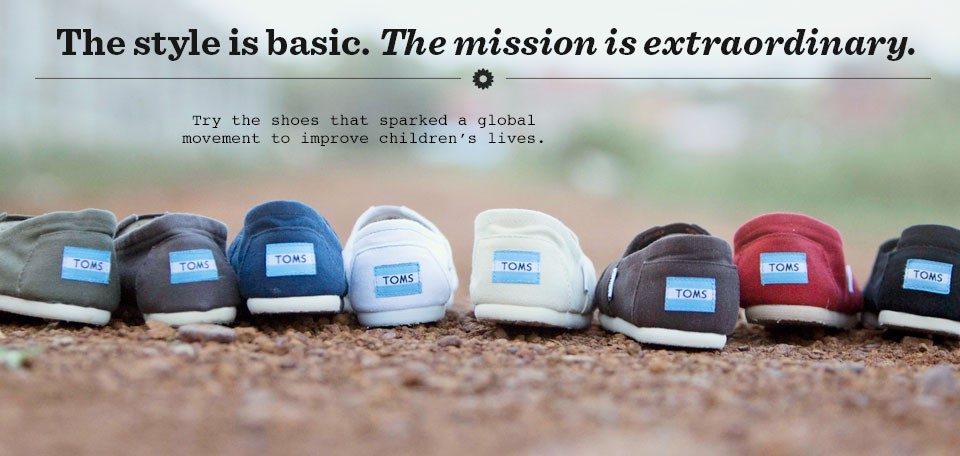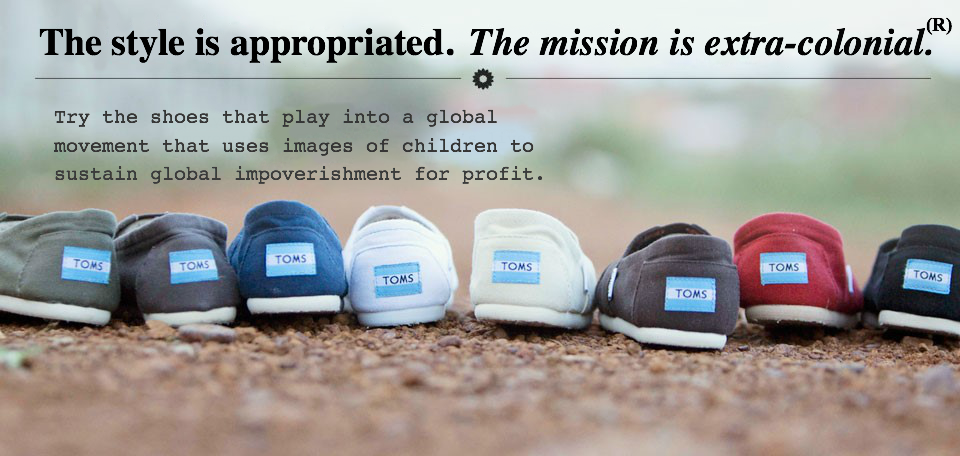(1) In conducting my research for this assignment, initially I had thought to seek out advertisements that had explicitly been widely called “controversial.” However, thinking back to the video on the ethics of consumption and cultural capitalism that we watched a few weeks ago, I wanted to explore further how the buying and selling of a product or service relies on taken-for-granted conceptions of the world, including moral responsibility and its decontextualization through the obfuscation of its connections to patterns of violence.
TOMS is most well-known for their One for One campaign, in which they claim that for each purchase of a pair of their shoes, they will send a second pair to a person in need–namely a child from the global south. However, as it has been pointed out, including on TOMS’ own website, the corporate venture that ‘began everything’ was Blake Mycoskie’s ‘inspiration’ by alpargatas, which he saw as an opportunity to mass produce and market via a philosophy of ethical consumerism, as shown by the TOMS’ ad below:

TOMS’ original advertisement, unedited
While TOMS has addressed the source of inspiration of their shoes, they are shown to remove themselves from the implications of their actions (i.e. calling the style of their shoes “basic”). TOMS’ distancing from the implications and effects of their actions extends to their claim that their ‘mission’ is “extraordinary,” centering their advertising on the individual consumer who can make a difference through their purchasing power (telling the viewer of their ad to “try [their] shoes”) and individualizing of their ‘movement’ / ‘mission’ (i.e. claiming that the shoes “sparked a global movement”). This implicitly embraces a position of innocence through putting positive intentions above acknowledging complicity and a relationship to something much bigger.
In my jammed version of the ad, I seek to address TOMS’ corporate venture’s connections to broader systemic oppression. In unpacking the colonial implications of the ad, I seek to challenge the ethical conceptions that the ad presents to audiences.

My jammed version of TOMS’ ad
(2) In creating my jammed advertisement using Pixlr, I wanted to make sure to keep the style of the original ad, while altering its message through direct changes to its words. For example, I changed “basic” to “appropriated.”
I changed the ad’s subtitle to trouble the idea that TOMS is unique by invoking how TOMS not only plays into the narrative of the liberal individual by putting onus on the consumer to purchase their shoes to help ‘improve’ the lives of impoverished children, but in claiming that they “sparked a global movement,” they claim a position of innocence and disconnection from broader legacies / patterns of (structural) violence. The usage of children plays an important role in TOMS campaigning, particularly because of taken-for-granted ideas about the subject of the third world child, who is at-risk and must be saved–treated as a source of possible futurity or an investment in the neoliberal narrative. As it has been pointed out by Michelle Murphy (2013), the figure of the (often) racialized, third world girl has become an iconic vessel of human capital. Thus, in my jammed piece I try to address the corporate utilization of the image of the (racialized) helpless child that is eternalized through ad campaigns such as TOMS,’ in contrast to their claims of transformation. The subject of the child, as implied in the original ad, serves as a means of justifying paternalistic, colonial action that operates against the self-determination and genuine liberation of communities. For example, TOMS fails to address the effects of their actions on professional shoe crafters in both the nations that they ‘charitably’ send their shoes and in transnational communities in the global north.
In my work I have sought to point out the absurdity of TOMS’ ethical consumptionist claims, pointing to the coloniality of their actions and taken-for-granted beliefs that they seek to rationalize to potential consumers (“The mission is extra colonial.®”). Mirroring the sense of responsibility imposed by the original social message of the ad, I highlight complicity in something much bigger than the ‘movement’ that TOMS claims to have ‘sparked’ and beyond the individual on which their advertising is centered–reflecting the ways in which ethical consumerist ventures such as TOMS’ are linked to racist, anti-black colonial and gendered constructions that upholds / perpetuates the images of the white saviour and the impoverished, perpetually incapable person of colour (particularly black or brown) through material consequences and the erasure of colonial violence. By pointing to the globality of impoverishment, I also seek to challenge binary ideas of the first world versus third world (or global north versus global south) on which TOMS thrives on that displaces transnational and diasporic identities and settler colonial violence.
Recent Comments